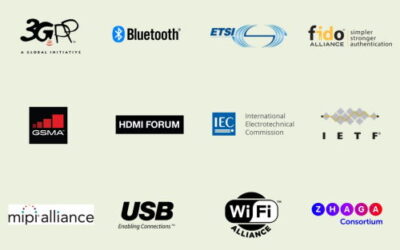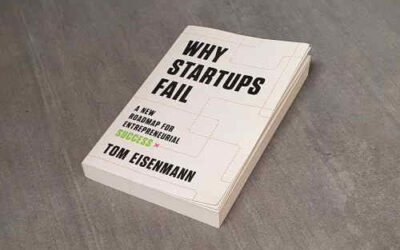Table of Contents
- Participating in standards development is difficult to justify
- How to create value by participating in standards development
- New standard or improvements in an existing standard?
- Special case: standardizing an existing proprietary product interface
- Lessons for startup participation in standards development
1. Participation in standards development is difficult to justify
Participation in standards development is expensive. Scarce technical experts need to spend time on discussions that have no immediate benefits for the company. Developing standards takes years. And, when finished, the adoption of standards tends to be slow. It takes years before investments pay back.
Network effects preventing fast adoption
The adoption of interface standards is particularly slow when the product introduction is subject to network effects. The Wi-Fi standard (802.11) was first released in 1997. In 2002, five years later, the sales volume of Wi-Fi chipsets was still below 10M unit per year. Bluetooth 1.0 was released in 1999 and it took until 2002 before shipments exceeded 10M units per year.
The development of interface standards is not only slow, mass market adoption can even fail. The risk of failure is particularly high when two competing interface standards compete for adoption (“standards battle”). The list of failed standards is long: Betamax, DVD-Audio, Home-RF, PMA, …
This article is about interface standards – regulatory standards are different
This article is about the standardization of product interfaces with the goal to make products by different manufacturers compatible. These companies participate in standard development organizations that are industry alliances (also called industry consortiums). Regulatory standards are created differently, by organizations like ISO, IEC and ITU. The members of ISO, IEC and ITU are countries, not companies. Regulatory standards are, for example, about product safety, or they regulate the use of electro-magnetic spectrum.
2. How to create value by participating in standards development
Companies have different ways to justify the cost of participating in standards development. The justification and method of participation depend on the company’s product and business model.
2.1 Value for companies selling consumer products
Companies that sell consumer products can justify their participation when the standard enables a new feature, or delivers performance improvements that improve sales margin, increase market share, or open new markets that could not be served before.
What can consumer product manufacturers contribute to standardization?
Companies that sell consumer products are very influential. The standard will fail when they cannot be convinced to use the standard. That’s why other participants will listen carefully when these companies explain their requirements. These companies are key to solve the “penguin problem” (sometimes also called “chicken and egg problem”). By adding the standard to their roadmap, and asking their suppliers for quotes, they can convince component manufacturers to invest long before the standard is fully ready.
Contributing technical solutions is possible only when a consumer product company has its own R&D program.
What the best way to participate in standardization?
Even when a consumer product company doesn’t have the technical expertise to contribute to discussions about the specification, it can influence the evolution of the standard. A small delegation can focus on formulating requirements that match the company’s interest. It is important to appoint a person who finds it easy to speak up in large groups and is a good networker. Influence can be increased by volunteering for management roles in the standard development organization, although that tends to take more time than participating with a focus on requirements only.
Consumer product companies have more options when have their own R&D expertise in the standard’s main technologies. They can send a larger delegation and influence the technical choices, not only by stating requirements, but by actively verifying that requirements are met and by contributing own technology.
Companies that don’t have their own R&D expertise can also team up with a supplier and develop joint contributions that match the company’s need.
How is participation in standards development funded?
A one-person participation in standards development can be justified easily because it will not require a full time employee and the knowledge about the maturity of the standard will (a) help get the timing of product introduction right and (b) help negotiate with suppliers of components.
It is much harder to justify a contribution by the company’s R&D team. A meaningful contribution can easily require more than one full-time employee. And these experts are scarce. They will not be working on product development when they are doing standards development.
Consumer product companies can, however, be successful in benefiting from contributing R&D resources to standards development. Some of these companies fund the contribution out of their intellectual property department with the justification that the activity will help lower future royalty payments or and may even create royalty income on essential patents.
Is creating patents useful for consumer product manufacturers?
Consumer product companies that don’t have their own R&D expertise may be able to generate non-essential patents that cover the application of the standard in products. These patents create a sustainable competitive advantage by making it harder for competitors to copy products.
Creating standard essential patents requires R&D effort and expertise to deliver solutions that are better than proposals by others. Consumer product companies are well positioned to generate relevant patents because they have better knowledge about the problems that the standard must solve.
2.2 Value for companies selling components
Manufacturers of components, usually ICs, risk loosing market share when their portfolio of components doesn’t support a new standard. They can win new customers by being the first to offer the new feature, preferably when the standard is not even finished.
Their challenge is that there are far more emerging standards and far more promising new technologies than they can possibly integrate. They need to choose and get the timing right. Invest too early and discover that the earlier version of the standard becomes obsolete. Invest too late and see your customers switch to a competitor.
What can components suppliers contribute to standardization?
Companies that design and sell ICs tend to be the main contributors of technology in industry standards development. They have the systems knowledge that is needed to integrate a new technology into much bigger systems such as mobile phones and vehicles. They also tend to have a larger pool of technical experts, compared with most consumer product companies.
What the best way to participate in standardization?
I have seen component suppliers use two strategies:
1) Passive participation. Listen to the discussions and use the interface specification to develop products.
2) Active participation. Contribute proposals, review proposals by others, build prototypes and contribute measurement results.
Active participation in standards development results in better understanding of the interface. Participating with early prototypes in interoperability testing reduces the risk that own components are not fully compliant and give users a bad experience. Active participation also creates goodwill from other participants. That goodwill can be very valuable when a component that is almost ready, or already installed in products, turns out to be not fully compatible with other products. I have seen a standards development organization make a change in the interface specification to solve a design error in a component of one of the members.
How is participation in standards development funded?
Active participation is expensive and needs a long term commitment. Companies that need access to many standards can benefit from deciding at corporate level in which standards to be active instead of passive, and fund the participation fully or partially from corporate overheads instead of leaving it to the development budget for a specific component.
Is creating patents useful for component suppliers?
Patents on non-essential aspects of implementing a standard (cost reduction or performance improvements for example) are useful. Patents are non-essential when there are alternative implementations that are feasible but not necessarily as good.
Creating essential IPR is not particularly useful for component suppliers because essential patents must be licensed to competitors and cannot be used to protect a differentiating feature. And royalty collection on essential patents may require legal action against customers of other components and that will interfere with product sales.
Some component suppliers have successfully combined patent licensing with component sales. Qualcomm is the most prominent example. Qualcomm’s method of collecting royalties on mobile phones that use a competitor’s chip is controversial.
2.3 Value for companies selling technology and patent licenses
Companies with technology that is needed to implement the standard may be able to collect royalties. That is usually in the form of a patent license (for standard essential patents), but in unusual circumstances also be a trade secret license, or a chip that must be purchased.
Open standard development organizations, that give voting rights to any company willing to pay the membership fee, will not write an interface specification that requires a trade secret license for its implementation. When a chip is needed, an open standard development organization will make sure that there are multiple suppliers competing for supply of these chips.
It is very difficult for companies to successfully partcipate in standards development with a business model that depends only on royalty collection. The payback term is long, the risk that the standard fails is high, and the risk is high that patents are not good enough for enforcement.
Most companies will use the option to collect royalties as a secondary benefit, with product sales or components sales as primary justification.
Attempts to include pre-existing proprietary technology in the standard
One strategy is particularly risky: Participating in standards development with the goal to get an existing proprietary technology included in the standard has a high failure probability.
Technologies will only be selected by the SDO when they solve a problem, and solve it better than alternative solutions. It could be a technology that was developed previously for an unrelated application. Quite often it is a solution for a problem that is discovered during standards development and specific for that standard.
Solve real problems faced by the product companies
Companies that are not themselves active in developing products and components will have difficulty coming up with contributions that solve real problems faced by the product companies. They risk focusing on solutions they can provide instead solutions that are needed. Teaming up with a consumer product company will help mitigate that risk.
3. New standard or improvements in an existing standard?
The analysis above assumes that the standard introduced new functionality. The dynamics are somewhat different when participating in standards development of the next generation of a successful standard (4G as improvement of the successful GSM standard for example). The risk of standards battle disappeared. The potential value of participating is now obvious.
Successful standards attract participants with ideas and technology that can be used to improve the standard. Meetings become large, with attendants from many companies.
The decision-making process changes when the number of participants and commercial interests increase. It becomes more difficult to be heard when proposing a solution or raising a concern about a proposed change in the standard. Participants will find it more difficult to determine which solution among proposed alternatives is superior.
Companies must increase the size of the team that participates in standards development when they want to remain active and influence the development of the standard. Small companies will find it increasingly difficult to participate actively.
4. Special case: standardizing an existing proprietary product interface
A company that has developed a new type of product interface may discover that customers will only implement the interface when the interface is an open standard with unconstrained competition between suppliers.
What can a company do when it needs to standardize its proprietary interface?
There are two main options:
(a) Create a proprietary standard
The company can develop the interface specification alone. Business partners may be willing to contribute, but licensees are unlikely to help. Licensees will be passive. They use the specification to make products but otherwise avoid contributing to the success of the standard because they will not benefit from the success and will be at the disadvantage when the licensing company is also selling competing products.
A good example, also of the limitations of this model, is the PMA standard for wireless charging of mobile phones.
(b) Create an open standard
The alternative is to contribute the specification of the interface to an open standards organization in which many companies and even competitors have voting rights. The standard development organization will probably require that the company makes its essential patents available on royalty-free RAND conditions.
The justification will need to come from selling products in a market that has become orders or magnitude larger because of the availability of an open standard.
A good example is Ubico’s contribution of their YubiKey specification to the FIDO Alliance.
5. Lessons for startup participation in standards development
Participation in standards development is very problematic for startups. A three to five year effort before products get mass market adoption, with almost no income in the meantime, is too long for most investors.
Make sure that investors understand the timeline and risks when standardization is the only way to monetize a technology.
Startups can try to survive by minimizing costs and finding a small niche for products that don’t need a standard interface. Then delay investments in growth until the standard is successful. But beware, it is easy to end up in limbo when the predicted adoption of your technology keeps getting delayed into the future. Many startups that dream of delivering “power through the air” ended up in such limbo.
Picture shows the result of fundraising for victims of a 1929 flood by the Amsterdam fire brigade. Courtesy Stadsarchief Amsterdam




